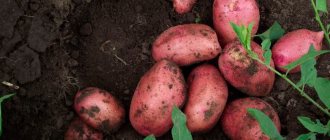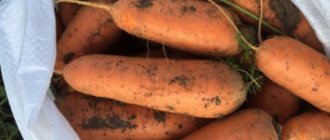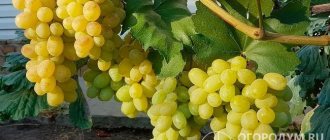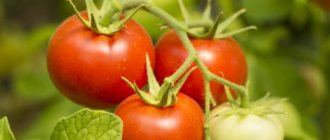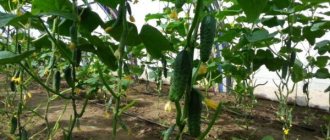Origin story
The Innovator variety is the product of the work of Dutch breeders. In Russia, a new potato variety intended for commercial production has been grown since 2005, when it entered the State Register. Recommended for all central and Volga regions, i.e. climatic conditions of the central zone of the country. But it gained popularity in Siberia and the southern steppe regions. Now many farms are included in the State Register as domestic originators of seed material of the Innovator variety: from the Moscow region, Tyumen, Sverdlovsk regions, Stavropol Territory, Tatarstan.
Pedigree
Innovator was bred by breeders of the Dutch company HZPC Holland BV, which is the originator, patent holder and main supplier of seeds and seed tubers of the variety to the world market.
HZPC Holland BV is a leader in the global seed potato market. Exports products to Europe, Asia, North and South America, and Africa.
Specializes in the selection of varieties intended for sale in packaged form in supermarkets, culinary use in fast food chains, production of chips and French fries.
In Russia, elite seed material produced on the basis of a large seed production branch located in the Leningrad region is sold. To avoid degeneration and accumulation of latent viral diseases, all seed products belong to groups E (elite), A (first reproduction).
In 2002, the Innovator potato variety was included in the State Register of the Russian Federation for regions 3, 4, 5 (Central, Central Black Earth, Volga-Vyatka). Passed standardization in Moldova, Ukraine.
Description and characteristics
Stable yields have made the mid-early Innovator potato popular among industrial crop producers. Harvesting begins after 75-85 days of plant development. They get 320-330 centners per hectare. The maximum yield of the Innovator variety was obtained in the Kirov region: 344 c/ha. On personal plots with 1 m2 you can harvest 15 to 30 kg of potatoes. The marketability of the harvest ranges from 82 to 96%, there are few small tubers.
The Innovator potato bush develops up to 60-70 cm in height. Semi-erect, spreading stems grow quickly, with medium foliage. The large leaves are slightly wavy and light green. Lots of white, large flowers. Berries are rarely produced.
The tubers of the Innovator variety are oval, oblong, covered with a light yellow rough skin, with small, flat eyes. From 6 to 11 large, uniform potatoes are formed in the nest, weighing from 83 to 147 g. The light cream flesh of the Innovator potato is dense, slightly boiled, and retains a pleasant color after cooking or freezing. Contains 12-15% starch, 21.3% dry matter. The tasting score is 3 and 4 points.
The Innovator variety, thanks to its dense structure, has established itself as one of the best for preparing salads, French fries, baking in foil, frying or stewing. The tubers are used to make chips and puree powder.
The keeping quality of the variety reaches 95%, with an average dormant period. Innovator potatoes tolerate mechanical damage, are suitable for long-distance transportation, and can be stored for 3-4 months, which is a good indicator for an early variety.
Plantings of the Innovator variety are resistant to typical diseases: pale potato nematode, potato cancer. But the golden potato cyst nematode parasitizes the plant. The innovator demonstrates average resistance to late blight and scab. The variety is susceptible to the fungal disease rhizoctonia and attacks by the Colorado potato beetle.
Important! The variety tolerates short-term drought and is suitable for growing in steppe regions.
Features of cultivation
Large tubers weighing at least 80 g are selected for planting. In unfavorable weather conditions, they will provide the plants with a sufficient supply of nutrients. To activate the growth of the tubers, it is recommended to warm them in warm water and then treat them with growth stimulants.
For greater safety, the seed is generously sprayed with an aqueous solution of fungicide. After processing, the tubers are thoroughly dried, all components should be well absorbed. Then the tubers are germinated in the light. The appearance of strong white sprouts about 2 cm long is a signal for immediate planting.
Potatoes can be propagated by seeds. Germination is average, in the first year the yield is significantly lower, but already in the second season the plants will demonstrate all the best qualities, the tubers will be larger.
It is better to plant potatoes in warm soil; its temperature should exceed 10 degrees. It is more convenient to place the seed in rows; the tubers are laid out in holes fertilized with humus and wood ash. The bushes are placed at a distance of 30-35 cm from each other, row spacing should not be less than 60 cm. The depth of planting root crops is about 10 cm.
During the planting season, they are fed with complex fertilizer or diluted mullein. Read here when and how to fertilize. The variety is sensitive to humidity levels. To obtain maximum yield, it is recommended to organize drip irrigation.
To prevent the soil from drying out and weeds from bothering young potatoes, the rows are mulched with mown grass, straw or peat. Plantings are hilled 1-2 times, forming high ridges.
A week before harvesting, it is recommended to cut off the tops; this will allow the tubers to quickly gain marketable weight. After digging, the root crops are dried on the boundary or under a canopy, sorted and stored in a cool, dark place. Seed material for the next year is stored separately.
Landing
According to potato growers, any soil is suitable for the Innovator variety, although it works best on fertile sandy loam soils with a neutral or slightly acidic reaction. In such areas, water does not stagnate, and oxygen easily penetrates to the tubers. Heavy clay soils need structuring, adding a bucket of sawdust or sand per 1 m2. Acidity is reduced by adding 500 g of lime or 200 g of dolomite flour. In spring, a glass of wood ash is placed in the holes. The soil is prepared and fertilized with humus, compost, and superphosphate during autumn plowing.
In the middle climate zone, Innovator potatoes are planted in May, when the soil temperature rises to 7°C. A month and a half before planting, seed potatoes are taken out of storage, sorted and germinated.
- Lay out the tubers in 2-3 layers;
- The room temperature is not higher than 17°C;
- Before planting, tubers without seedlings are discarded and treated with growth stimulants according to the instructions;
- The tubers are also sprayed with special pre-planting insecticides directed against the Colorado potato beetle;
- Layout of nests for the Innovator potato variety: 70 x 25-40 cm. Small tubers are planted more densely, and large ones less often.
Warning! When planting, Innovator potato seed tubers are deepened slightly more than other varieties.
Agricultural technology
Preparation
To plant varietal Innovator potatoes, selected tubers, pre-germinated in the light, are used, which have also undergone additional treatment with biostimulants and antiviral drugs.
In order to obtain an early harvest, germination should begin approximately 40-50 days before the tubers are planted. The procedure for carrying out this procedure is as follows:
- First, the seed tubers are laid out in boxes, in a layer approximately 2-3 cm thick.
- Then they are sprayed with water (this should be done at least 1-2 times a day).
Note! During the germination process, a certain temperature must be maintained in the room (the first 7 days - about +18-20, then - plus 15-17 degrees)
- After about three weeks, the tubers are culled, during which only samples with already formed skins and full-fledged sprouts are left.
- They are placed in boxes with humus and peat, always with the sprouts facing up.
- After that, they are sprinkled with the same mixture, then the process is repeated several times.
Note! When forming a germination zone, the total number of rows should not be more than 3-4. For subsequent moistening of selected tubers, it is recommended to use a liquid solution of mineral fertilizers
Disembarkation
It is preferable to plant this type of potato in beds slightly raised above the general ground level (the time for this is usually chosen in May). When planting tubers, the distance between adjacent rows should be about 70-75 cm, between tubers - from 25 to 40 cm (depending on their size).
Additional Information. It is recommended to grow potatoes in places where legumes or perennial herbs, as well as tomatoes, cucumbers, cabbage, onions, garlic or peppers previously grew.
The Innovator variety, a detailed description of which was discussed above, requires slightly acidic (neutral) soils for good germination. Good results can be obtained on sandy loam and purely sandy soils.
If necessary, it will be possible to further enrich them with special acid-nutrient compounds, which can be purchased at any specialized store.
On a note. Immediately before planting, mineral fertilizers mixed with wood ash are applied to the soil.
Traditionally, potato care comes down to the following mandatory procedures:
- Weeding and then hilling the seedlings.
- Mulching and watering.
- Treatment with pesticides.
Weeding and hilling work is carried out at least 3 times during the summer season. To prevent the growth of weeds, the beds are sprayed with pesticides, and the first watering of potatoes is tied to the time of the appearance of inflorescences. The second time it is watered immediately after flowering stops. Further watering operations are organized as needed (avoiding moisture stagnation).
Care
The plot with potatoes of the Innovator variety is regularly loosened to remove weeds. If necessary, the beds are watered if the weather is hot. For potatoes, watering during the bud phase and after flowering is important.
Hilling and feeding
After rains or watering, hilling is carried out at least three times, having time to form high ridges before the Innovator potatoes bloom. Feed by watering between the rows with mullein (1:10) or bird droppings (1:15). These fertilizers are also ready for sale. Before the first hilling, 500 ml of a solution of 20 g of urea or ammonium nitrate in 10 liters of water is poured under the root of the Innovator variety.
Reviews about the variety
Recently, most large companies and farms prefer to grow potatoes of the “Innovator” variety.
The variety can be grown not only for personal consumption, but also on an industrial scale for sale. Table potatoes of the “Innovator” variety enjoy well-deserved attention from owners of large agricultural companies and amateur gardeners. Thanks to its immunity to some diseases, the Innovator variety is quite easy to grow. It is characterized by high marketability, productivity and keeping quality.
Diseases and pests
| Disease/pests | Signs | Control measures |
| Late blight | There are brown spots on the leaves. White coating underneath | Hilling up potatoes until the leaves close in the bush. Spraying with copper sulfate 15 days after germination |
| Rhizoctoniosis | Infection could have occurred through the planting of tubers with black, rough spots. Black rotting spots on the bottom of the stems, white coating on the leaves | Spraying tubers before planting with boric acid - 1% solution or fungicide Ditan M-45 (80%) |
| Powdery scab | White growths are noticeable on the stems, which turn brown and shredded over time | Before laying, the tubers are treated with a 5% solution of copper sulfate |
| Golden potato cyst nematode | Small microscopic worms live on the roots. During flowering, the plant turns yellow and the lower leaves fall off. The roots become fibrous. The nematode remains in the form of a cyst and spreads easily, remains viable for up to 10 years | The tops and all plant residues are burned. Potatoes are planted on the plot after 4 years |
Advice! Rhizoctonia disease can be avoided by planting tubers in sufficiently warm soil.

